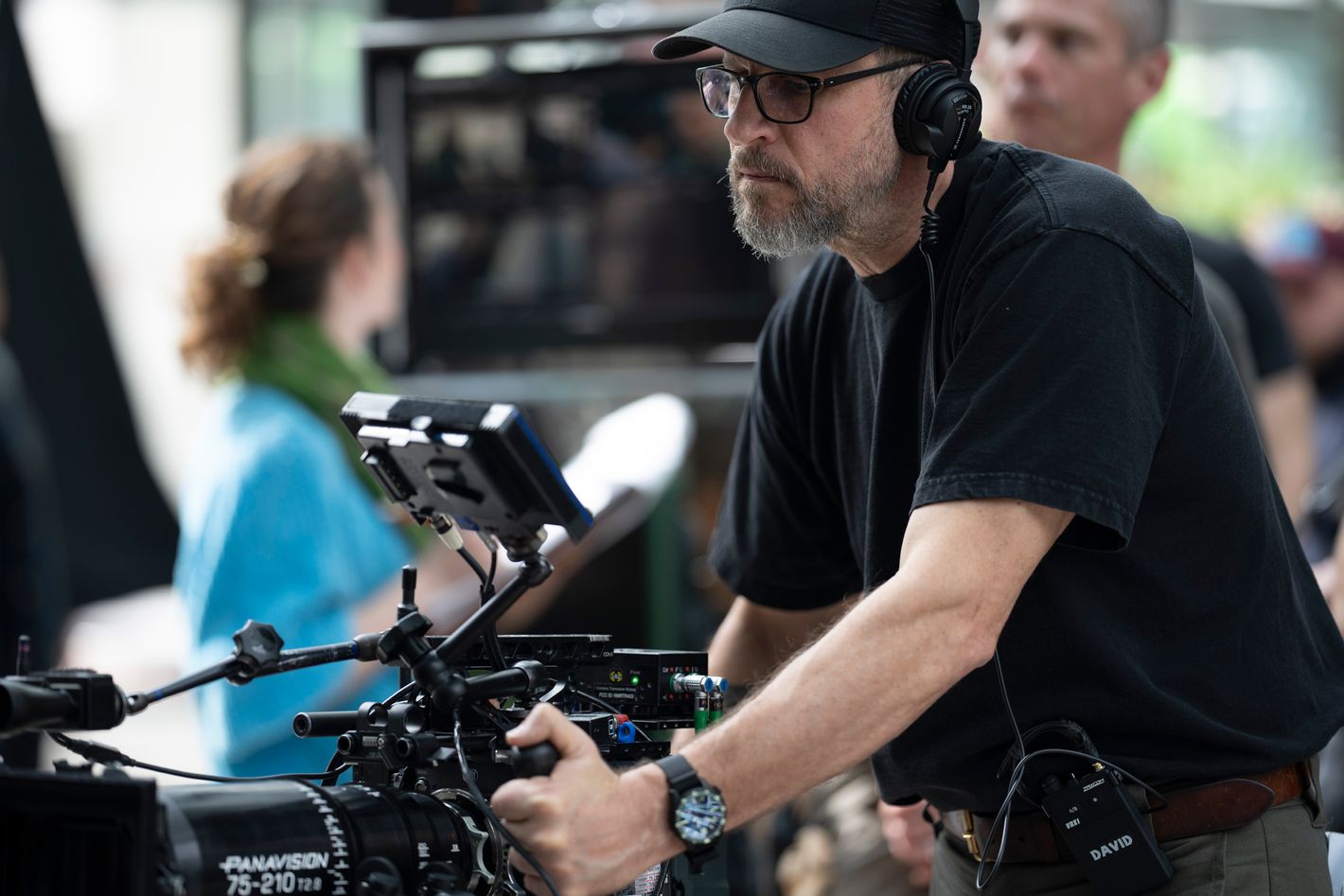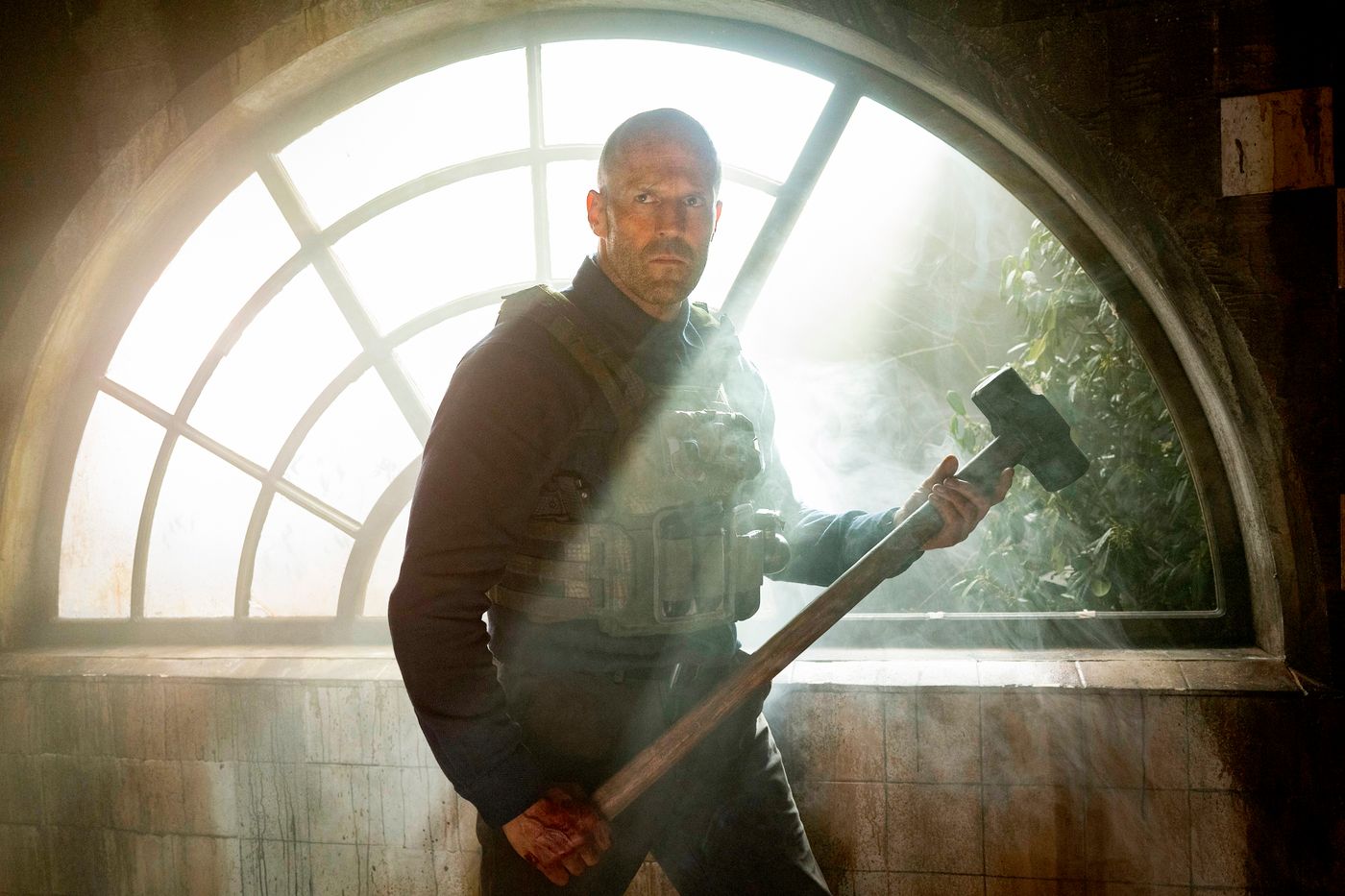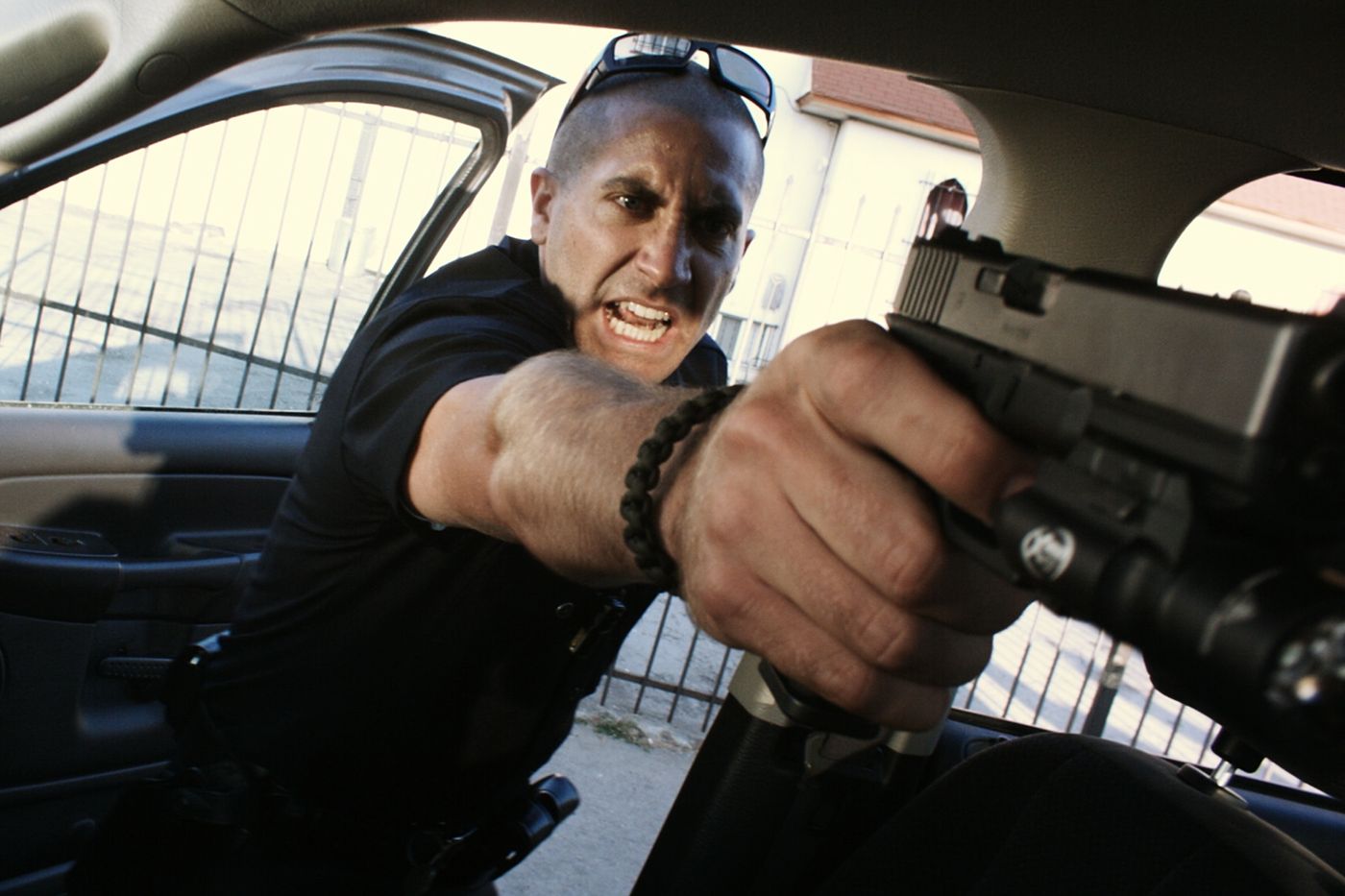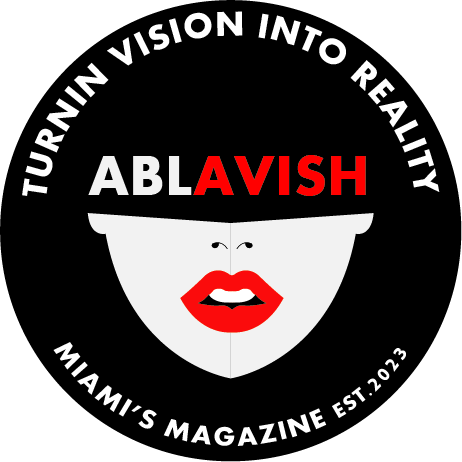

David Ayer, director of A Working Man, has had one of the most deceptively fascinating careers in today’s Hollywood. His early films as a director — Harsh Times, End of Watch, Street Kings — were intense Los Angeles crime dramas very much in the vein of his best-known script, Training Day. They drew on his personal familiarity with this world; after moving around the country as a child, Ayer spent part of his teenage years in South Central L.A., most of the time on probation, before going into the Navy. These movies starred the likes of Christian Bale, Jake Gyllenhaal, and Keanu Reeves, and although they had popular elements and heavy doses of action, they were also compelling deconstructions of modern masculinity, portraying blustery, haunted characters (often cops, or aspiring cops, and usually ex-military) who egged each other into darker, more dangerous places. This was true of Fury (2015) as well, his brutal and gruesome war drama featuring Brad Pitt as a tank commander in the final days of World War II leading a platoon of hardened, traumatized, broken soldiers.
Maybe it was also true of his cut of Suicide Squad (2016), but we’ve never seen it. That critically savaged comic book flick was reshot and recut into a release version reportedly nothing like Ayer’s original. Since then, he has become more of a pure action director. The visceral savagery he brought to last year’s Jason Statham vehicle The Beekeeper felt like an ideal match of director and star, which is perhaps why the duo reteamed for this latest film as well. But he still has L.A. stories he’d like to tell. And he’d still love to show us that now-infamous “Ayer cut” of Suicide Squad.
I enjoyed the fantastical and colorful world of A Working Man — the bad guys with all their garish, crazy clothes, and that giant full moon in the background. Were these elements you brought to it?
Yeah. Chuck Dixon’s books are pretty hardscrabble — Tampa, Florida, really raw. But I started to see it as a little bit of a fairytale. When I go into the process, I’ll do illustrations, and all my illustrations were these gothic key-frames. That moon was something we physically built and placed on the set. The thing was 45 feet across or something. It was crazy. I wanted this heightened fairytale thing, and to run Jason through that maze. I really learned how to photograph him and learned his visual voice and style during Beekeeper. So, I was able to make it a little more elevated visually here. Part of maturing as a director for me has been realizing, “Hey, I can try different styles, I can try different voices and genres.”
When you say you learned how to film him, and his visual style, what do you mean by that?
There’s an alchemy to superstars, and they all have something in common in that they’re savants of human movement. They know how to move in front of a camera in ways that heighten their presence. Humphrey Bogart — a classic example of a star interacting with photography in such a way to get a bigger result. So, when I started to understand how to photograph Jason — literally, what lenses, what angles, how does he move, understanding his body language and movement — I was really able to heroicize him.
For years, I’ve done a ranked list of the Worst Ways To Be Killed by Jason Statham. And it’s made me pay attention to how he’s filmed and cut. There is this Buster Keaton quality. He’s got the stone face, but he also works a lot in wide shots, so there’s a great tension between this stoic, almost unreal visage, and then this relatively short guy who moves like the Tasmanian Devil.
It’s very much a part of how he sees himself as a performer. It permeates everything he does. He was a diver and represented Britain, and those divers have an incredible understanding of body position and kinetics and gravity and motion. He took that into martial arts and Muay Thai and combined that. One thing he educated me on was the idea of body shapes. We’d choreo these fights and it’s like, “What are the shapes his body will be making during these action beats?” Learning how to shoot him is about understanding his physical grammar. What are the motion fragments we can put together to create these fight scenes? Finding that flow in the motion and the photography. It’s an immense amount of work, but he’s the best palette ever to do that with.

He’s also one of the last stars still doing action movies of a particular type. He and Gerard Butler (a very different actor, to be fair) are doing throwback action that recalls the movies a lot of us grew up on — movies that used to be a dime a dozen, so we took them for granted.
That’s exactly it right there. He’s like the last baton relay runner, and he has that whole cinematic legacy on his back. I’m a student of those movies, and he can carry that kind of vehicle.
With both the tech bros in A Working Man and the mobsters in The Beekeeper, we really do sense that the rich and powerful live in completely different worlds. They’re in these stylized cocoons, and they literally cannot conceive of the rest of us as actual human beings. I know these aren’t “political” movies — but there is a politics there. I think that helps the films really connect with audiences.
If you look at the world today and how disempowered your average person may feel, especially in the face of big things happening and big systems that are really impersonal now and at scale, it’s easy to just feel lost. Having an avatar, having someone to go in and right injustice is such a primally satisfying need for people, for audiences. Maybe that’s like in the ‘70s, when you had a terrible recession — the oil crisis, lines at the gas pump — and these average man avenger archetypes popping up in movies. Even in the early ‘80s, you had a repeat of that. Superman was a product of that, in the ’30s. The world was on the brink of war, horrific things were happening in Europe, and these guys in New York are like, “I want to write an empowering character that creates some sense of hope in this world.” I think that these cycles roll through time.
For much of your career, you found personal angles into the stories you were telling. You made more of a pivot in recent years to action. Was it a conscious adjustment? Was it just how the industry is evolving?
I don’t know, maybe it’s everything. I did my first action in Harsh Times, my first movie. But the difference with an action movie is that’s the brand, that’s what we’re selling. “Hey, this is not a raw, heart-wrenching drama.” And channeling all my serious dramatic energy into a more fun vehicle, I enjoyed that process a lot more than I thought I would. I had a lot of experience shooting action, but when you’re making an action movie, you learn that you’ve really got to get your hands on the patient. That comes back to those ’70s, ’80s, ’90s classics of structure and story and how they work. Something like First Blood, for example, is a masterclass in making an action movie.
The difference seems to be between anticipating action and dreading action. In End of Watch, or Harsh Times, we’re watching and thinking, on some level, “Oh, please let the guns not come out.” We’re terrified of what might happen to these characters. Whereas in The Beekeeper, we’re like, “Oh, please let the guns come out. Please let’s see Statham kill somebody.” Doesn’t it feel like these movies engage different parts of our brains?
Yeah, exactly. A lot of my early movies were personal and working out whatever life stuff one does as an artist. I really enjoyed wearing the mantle of the dark, brooding artist. “I’m a rebel, and I want to do things my way.” Then you grow up, you get humbled, you start seeing things differently. You look at the market and what’s getting made. It’s a business that runs on spreadsheets and projections. As someone who wants to be sustainable today, you ask: How do we create something that people will want? Can I make the classic roller coaster movie that pulls people in and works for a lot of people and not just segments?
Business is a lot like the law, in that it doesn’t necessarily work the way you feel it should. It works the way it does whether you like it or not. Learning the business side just became like a survival mechanism; it’s a terrifying environment out there, and I’ll do what I have to do to survive. But making Beekeeper, I also discovered this amazing working relationship with Jason. So, it was a no-brainer to make another one.

I know you had a rough experience with Suicide Squad. As someone who liked a lot of what was in that film, I always felt it was a collision between your sensibility and the demands of a comic book movie. That now feels like a fulcrum in your career, in terms of the shift from doing more personal work into straight action. Was that a turning point?
For sure. It’s the Hollywood chutes and ladders. You’re up and you’re down. I was coming off Fury and I could kind of do anything I wanted. And I wanted to make a comic book movie. I wanted to do what the cool kids were doing. I went in and I made what I felt was this really human war movie. My Suicide Squad was a war movie. I had just come off a war movie and I made another war movie. There was a lot of character evolution. The first act in my film was all the backstory of Rick Flag and June Moone and their relationship and how they met. And the Joker-Harley Quinn backstory was more in keeping with the comic books, where it was this toxic relationship she had to escape from. So much context and setup and storylines were removed. The studio got ambushed by Batman v. Superman, and the release of that wasn’t the outcome they expected.
The most frustrating element, the hardest thing for me to explain or to be believed, is how different in its DNA my cut is. Normally, director’s cuts are like, “Okay, we put back in the deleted scenes” or whatever. No, this is an entire re-conception. I didn’t have a single needle drop in the film. Steven Price, who did Fury, wrote this beautiful intricate score. My film was gothic and lyrical and dramatic. The people that have seen my cut, it’s all been the same reaction: They get mad. “This is what we wanted. Why didn’t we get to see this?” There are flaws in it, but I think I made a really good film. And I definitely got schooled on what these projects really are, as a socio-political engineering consensus machine. I’ve taken so much heat because of the way they broke it. That got thrown back on me. And it’s like, “Guys, time out. That’s the exact opposite of what I was trying to do, and what I did.”
That really did create kind of a dark night of the soul for me as an artist. I was like, “Okay, this business is real. This is a full-contact sport.” That’s when I really started to lean into the business, and it took a long time. But yeah, that’s a definite turning point. And I want to get back to large-scale storytelling. Now that I know how to do the action movie and have a more popular voice, I can bring whatever personal shit I’m working through into that space, be a little more respectful to the audience and make some big, amazing movies.
Are there people along the way that you feel like you really learned a lot from?
Absolutely. My mentor, the guy who discovered me, was Wesley Strick, when I was in my early twenties, just a lost soul working construction. He let me into his world, and it was this incredible view of a top screenwriter’s working life. I witnessed him go through the writing process of Cape Fear, as he worked with Scorsese and Bob De Niro. He showed me a copy of Scorsese’s script and it had all these frames drawn in — every page had maybe a dozen frames drawn in of how he was going to shoot scenes, with these scribbles. I also helped Wes with some research and stuff. People have no idea how much craft goes into this. I saw how he operated and delivered within that world. That got me writing, and my first script wasn’t great at all, but it got me meetings, and people saw something in my writing that I didn’t even see.
I remember when Fury came out, it initially looked like it would be a classic war movie. They say that war movies, even the really dark ones, all end up glorifying war to some degree. But Fury to me is one of a handful of movies that really convey the total nightmare of war.
It’s funny, because in the military it’s pretty esteemed. I’ve heard so many times, “Hey, before our squad was deployed, we all sat down and watched Fury before we went downrange.” Maybe it’s that sense of masculinity, and life and responsibility and personality and all the masks we put on — now, here are these guys in this tank, and the war has stripped away all of that. So, they’re just together. There’s a hierarchy and a structure and rules, but there’s also this rawness. And the truest form of their personality comes out.

I’ve always been fascinated by that space in World War II. There’s so much truth in original sources. I read this battle report from early April 1945, when the war was basically over. This tank platoon, they get into this engagement. I think they lost 13 guys in one day. These guys fought savagely, just fought incredibly hard. A bunch of guys dying, in Germany, end in sight. What is happening in their minds and their hearts, in these little groups of men locked in these machines, that makes them fight on like that?
I had a lot of family in World War II. Both grandparents were in World War II, and they were career military officers. My uncle was a B17 tail gunner. I grew up raised by that generation of veterans and then raised by Vietnam veterans. All the men around me had this shadow, and it always seemed to go back to the war and nobody talked about it. Then you see all these movies and they’re all heightened and stylized and like, “Hey, we’re the good guys and we won.” They made combat seem almost fun. So it’s like, “What’s this disconnect?” That’s something that always haunted me, and I’ve always chased the truth of the war.
You were in the Navy. What was that like?
I was on a fast attack nuclear submarine out of San Diego, Cold War.
A different experience than something like Fury, I imagine.
For sure. But I did 67 days submerged. I know what it’s like to be locked in a machine for days. Not just the experience but also the closeness of it — the relationships. You really get close to people. I think that’s one of the reasons I’m a good writer is you just really witness what happens when everything’s stripped away. People get raw. And I’ve always been a student of people, I guess. Why do some people react this way? Why do some people react that way? That’s something I’ve carried forward.
You didn’t start screenwriting until you met Wesley Strick, but were you always a writer? Were you writing stories as a kid?
I dropped out of high school. I was not a good kid and definitely not a good student. But I would always write something at the beginning of the year in English. I think it’s an assessment they do. “Hey, write a few paragraphs about something.” I would just write something and they wouldn’t bug me for the rest of the year. They’d give me my D and everyone was cool. So, I knew I could write. I knew I had that skill. But I believe in that maxim: If you want to be a writer, you’ve got to get out there in the world and see life and have experiences. You can’t do it hiding in an apartment behind a computer.
Why do you think you were not a good student?
I just had a really rough childhood and moved all the time. Things were kind of broken. There was no incentive there, and I changed schools so many times. Also, I was just off in my head, I was always into movies. I was staying up all night watching movies, or reading. Just leaning heavily into my own world. Then you go to school and it’s like, “All right, this is really basic stuff. What are we doing here?”
Was this before you moved to L.A.?
Yeah, we lived all over the country. My dad died when I was four and then I was just… yeah.
What were your first memories of Los Angeles like?
It was the ‘84 Olympics. I was in South Central and it was such a different world. It was a totally new thing here, and it was violent and intense and real and raw. I was the only white kid, and it was just like, “Navigate, figure it out.” That just ended up really being very natural for me. In a lot of ways, that’s home, I guess.
Are there L.A. stories you still want to tell? A dream project you want to do?
Yeah, for sure. I love the Bogart movies and all those ’40s and ’50s noir films. So, how do you make a noir film today that’s going to be engaging to an audience, while doing a period piece like that? Because there’s just insane stories. L.A.’s always been the same. It has this intense dark past. Everything’s deed restricted. The first gang in L.A. was in Compton, but it was a white gang, and they were trying to keep African-Americans out of their neighborhood. East L.A. formed because if you weren’t white you couldn’t buy property on the west side of the L.A. River. So you had Latinos and the Japanese American and the Jewish communities there, all these groups that were excluded from what was the city center at the time. It’s wild. It’s just been this scrimmage between forces and society and people for so long. There are so many stories there.
It’s a fascinating era, but so many modern-day attempts at period noir crash and burn.
There are definitely rocks there, and you can wreck your ship fast. L.A. Confidential did a good job. But you have to be conscious. You can’t just be like, “Oh it’s a noir film. Look, it’s a new old movie.” It has to be a new new movie. It’s got to have the storytelling and consciousness and psychology that’s going to get a modern audience engaged.
How has your relationship with policing changed over the years?
I was literally on probation all through high school. I had to take the bus to Crenshaw/Exposition and check in with my probation officer. So, I started out running from them. But over time you get to know cops, you get to know their culture. There is a huge military-police crossover, and a lot of police are former military. You learn about the institutional politics, the institutional truths and how the game actually works. I’ve had this really privileged peek behind the curtain. A lot of cops have seen my work. End of Watch is revered — the poster’s up at Newton, and they slap the poster before they go on watch after roll call. So many say, “Hey, I can show my wife what I do for a living. My kids finally understand what is going on at work and why I feel some of these things I do.” Just like with Fury, people respect it when you respect their subculture and can depict that.
You also haven’t shied away from showing corruption in the force. A movie like Street Kings is pretty unflinching. Is that something you have to navigate with them, or are they kind of like, “No, no, we get it.”
People get it. I think the real corruption, the old-school, ripping off dope dealers, all the Rampart stuff and the pre-Rampart stuff, all the consent decrees and stuff — it’s different now. There’s body cameras, everything’s electronic. The cop car pulls in and there’s a wireless link to the station that just sucks in all the video in real time. It’s so scrutinized. The corruption is different now. It’s more like, “How do we keep the statistics up? How do we look good?” It’s less about personal enrichment or violence and more about fudging the numbers and fudging the culture. It’s all brand management now.
Obviously, in the wake of the Snyder cut of Justice League, you’ve talked about the possibility of your cut of Suicide Squad showing up at some point. Is there a finished film that could see the light of day? How much work would need to be done for it to happen?
It’s pretty much a finished film. Lee Smith, who edited The Dark Knight, cut it, and he’s amazing. The problem is there’s all this internal lore inside the studio about it. I don’t even know if anyone that has seen it is still there. It would take someone at the board level going, “Bring us the cut, we’re going to test it in some sort of blind NDA marketing test.” It would have to be a top corporate thing. Because it’s all IP management, right? And they’re trying to get their brand out, and James Gunn is rolling out Superman, so for them it’s a much bigger issue. They want to launch the new DC, and they have every right to do it unimpeded. They don’t want to start a negative conversation when they’re really trying to build up something new. And that’s fair, man. But would I love a screening? Just a screening, and let some film people see it? Yeah.
Related

Latest News
For Sale! 2016 Sea Ray 350 Sundancer – $180,000
Reel Deal Yacht is pleased to feature a meticulously maintained 2016 Sea...
‘Time to say goodbye’: Kevin De Bruyne to leave Man City
Kevin De Bruyne has announced he will leave Manchester City – bringing...
Auburn’s Pearl and St. John’s’ Pitino share AP coach of the year honors, 1st tie in history of award
Bruce Pearl has turned Auburn into a basketball school and may have...
NBA fines Grizzlies’ Ja Morant $75,000 for continued finger-gun gestures, after warning him to stop
Ja Morant showed off an imaginary gun. The NBA hit back with...
Gretzky set to be at Blackhawks-Capitals game with Ovechkin 3 goals from breaking his NHL record
Wayne Gretzky is expected to be in attendance Friday night in Washington...














Leave a comment